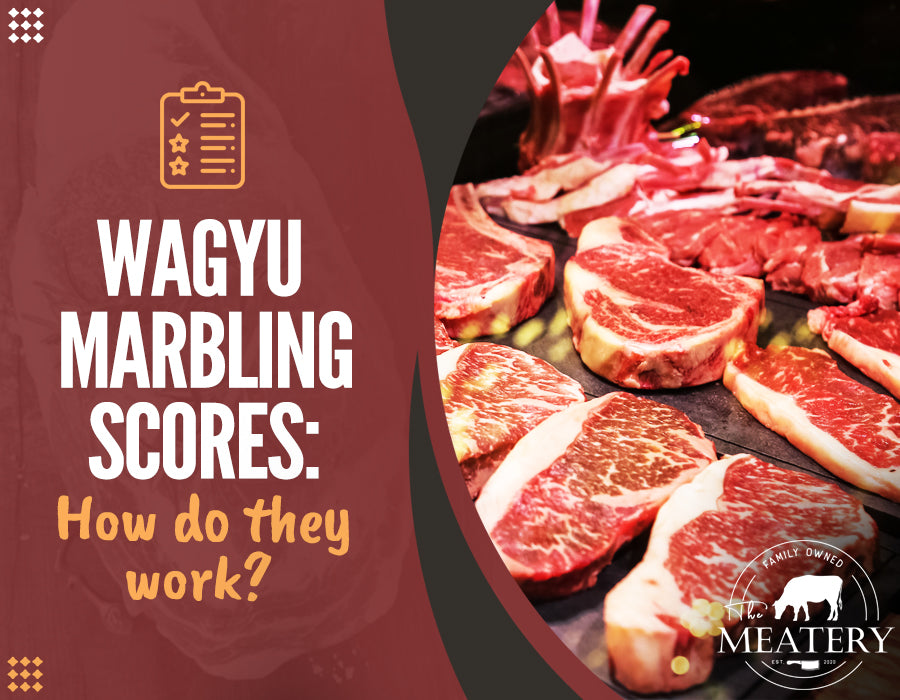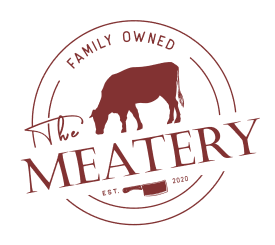If you’ve been curious about Wagyu, you may have come across a variety of Wagyu products that have been given a certain marbling score. Whether a cut of Wagyu is Japanese, Australian, or American, the marbling score of Wagyu plays directly into the flavor, tenderness, and cost.
Here, we go over Wagyu marbling scores from the largest Wagyu producing nations and how marbling scoring systems work and differ from region to region.
Understanding Wagyu Marbling Scores
Wagyu beef is treasured for its visibly rich intramuscular fat found between muscle fiber bundles, commonly referred to as “marbling”. The tenderness and rich flavor of Wagyu is directly derived from the fat that is commonly found in highly marbled examples. Wagyu marbling score ranges and numerical scores will differ from region to region and the association that grades the beef.
Japanese Wagyu Marbling Scores
The grading of Japanese Wagyu is conducted by the Japanese Meat Grading Association, or JMGA. The JMGA rates the marbling of beef using the Beef Marble Score, commonly abbreviated as BMS.
Japanese Beef Marble Scores range from 3 to 12, with 3 being the lowest level of marbling and 12 being the highest obtainable BMS. While a BMS 3 rated cut may contain very few signs of intramuscular fat, BMS 12 cuts will be nearly fully saturated with rich marbling. In 2008, the JMGA raised their standards and removed both BMS 1 and BMS 2 scores entirely, making BMS 3 the lowest marbling score obtainable for Wagyu beef.
Typically, the Beef Marble Score in the Japanese system is categorized as the following:
- 8-12: Excellent marbling
- 5-7: Above average marbling
- 3-4: Average marbling
Australian Wagyu Marbling Scores
The amount of fat within the muscle is graded in Australia using the AUS-MEAT beef quality grading system. Although the Australian grading system is similar to the Japanese system, the numbers used to measure the marbling of beef is different.
Unlike the Japanese system that utilizes the Beef Marble Score, or BMS, the Australian marbling grading scale is simply referred to as the Marble Score, or MS. In the Australian system, the scale goes from MS 0 to MS 9+, with MS 0 having minimal to no marbling and MS 9+ cuts showcasing extraordinary marbling. Although Australian Wagyu Marble Scores of MS 10, MS 11, and MS 12 do exist, they may typically be labeled as 9+.
While Marble Scores of MS 10, MS 11, and MS 12 exist, they are typically labeled as 9+. This makes it easier for consumers to identify high-quality options, such as our Australian Wagyu New York Strip MS 9+, known for its exceptional marbling and exquisite tenderness.
American Wagyu Marbling Scores
In America, the USDA (United States Department of Agriculture) determines the grading of certain cuts of beef. The USDA grades meats into 3 main categories: Select, Choice and Prime (from lowest marbling to highest). Both Choice and Select USDA grade cuts have very little or no marbling, and would not be given a BMS score if graded in Japan.
Choice and Prime USDA grades have their own subgrades. USDA Choice can come as Choice-, Choice, and Choice+. USDA Prime also has subgrades of Prime-, Prime, Prime+, and Prime++ (“Beyond Prime”). All American Wagyu will be measured as Prime++ (“Beyond Prime”), which can be graded as BMS 3 all the way to BMS 12 using the Japanese Beef Marble Score, depending on the marbling present.
For an exceptional marbling experience, cuts like the American Wagyu Ribeye Beyond Prime deliver unmatched flavor and tenderness, perfect for grilling or searing. Explore different marbling levels with options like the American Wagyu New York Strip or American Wagyu Filet Mignon, known for its buttery texture and rich marbling. Each cut showcases the unique characteristics of American Wagyu, making it a great choice for those seeking premium beef.
How Marbling Scores Affect Pricing
Wagyu beef is renowned for its exceptional marbling, a factor that significantly influences its price. Marbling refers to the fine streaks of fat interspersed within the muscle tissue, and it's one of the primary indicators of the meat’s quality, tenderness, and flavor. As the marbling score increases, so does the beef's value, resulting in a direct impact on pricing. Here's why:
1. Higher Marbling Scores Command Premium Prices
Wagyu beef with higher marbling scores—typically in the range of BMS 8 to 12—contains an abundance of finely dispersed intramuscular fat. This fat is what gives Wagyu its buttery texture and rich, melt-in-your-mouth flavor that sets it apart from other types of beef. As a result, cuts with higher marbling scores are often considered a luxury, and consumers are willing to pay a premium for this unique dining experience. The meticulous breeding, feeding, and care involved in producing highly marbled Wagyu beef further justify its elevated price point.
2. The Role of Marbling in Determining Value
Marbling scores are one of the most critical factors in grading Wagyu beef, directly influencing its market value. Beef with low marbling scores, such as BMS 1 to 4, is still flavorful but lacks the intricate fat distribution that Wagyu is famous for. These lower-scored cuts are generally more affordable and are often chosen for everyday cooking. On the other hand, mid-range scores (BMS 5 to 7) offer a balance of cost and quality, providing an indulgent experience without the top-tier price tag.
3. Scarcity and Exclusivity Drive Up Prices
High-marbling Wagyu is not only expensive to produce but also relatively scarce compared to other grades of beef. The meticulous standards required to achieve marbling scores at the top of the scale mean that only a small percentage of Wagyu beef meets these criteria. This scarcity creates a sense of exclusivity, driving up demand—and consequently, prices. Restaurants and specialty stores often market these cuts as premium offerings, catering to consumers willing to pay top dollar for an unparalleled taste experience.
4. Marbling as a Predictor of Consumer Satisfaction
The correlation between marbling scores and pricing is also a reflection of consumer expectations. People associate higher marbling scores with superior quality, and they are often prepared to invest in beef that promises an unforgettable culinary experience. This perceived value significantly affects pricing, with retailers and chefs adjusting their prices to match the anticipated dining satisfaction that comes with higher-marbled Wagyu cuts.
5. Choosing the Right Marbling Score for Your Budget
While higher marbling scores command higher prices, it’s essential to select a marbling score that aligns with your budget and taste preferences. Lower and mid-range scores can still offer excellent quality without breaking the bank, making them ideal for casual meals or experimenting with Wagyu at home. Understanding how marbling scores affect pricing allows you to make informed decisions and find the best Wagyu beef that fits your needs.
By understanding the relationship between marbling scores and pricing, consumers can better appreciate what they’re paying for and select Wagyu beef that matches both their taste and their budget.
Discover Premium Wagyu with The Meatery
Wagyu marbling scores will have a direct and noticeable impact on the taste, tenderness, and the pricing of beef. In order to find Wagyu beef with the highest marbling scores, you’ll need to find reputable vendors that work directly with both international and domestic producers. The Meatery works exclusively with worldwide producers of high-quality Japanese, Australian, and American Wagyu to ensure a memorable dining experience. To view our hand-selected cuts, or to learn more about our diverse offerings, visit us online or in-person at our San Diego butchery.









